Vocking B., Alt H., Dietzfelbinger M., Reischuk R., Scheideler C., Vollmer H., Wagner D. Algorithms Unplugged
Подождите немного. Документ загружается.

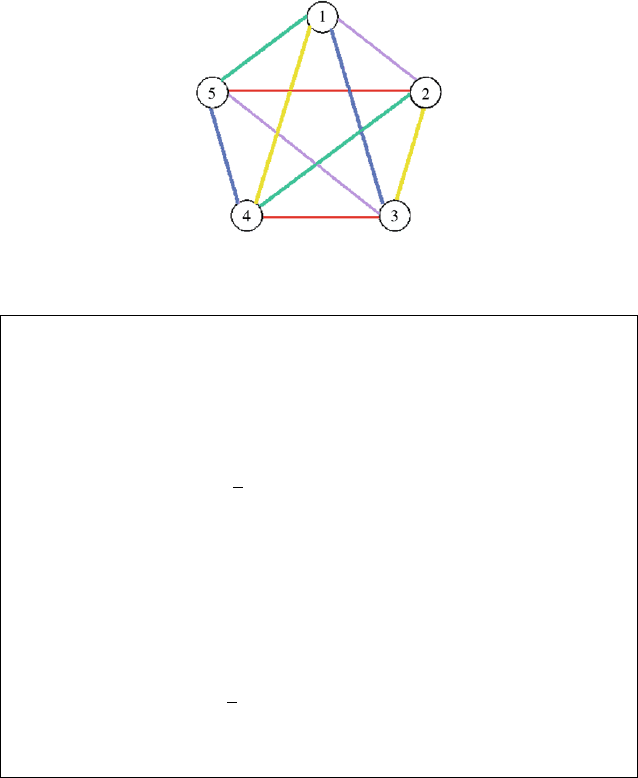
270 Sigrid Knust
Fig. 27.3. Resulting pentagon
Algorithm Edge Coloring (geometrical version):
1. Build a regular polygon from the vertices 1, 2,...,n−1 and place
the vertex n to the top left side beside the polygon.
2. Connect vertex n with the “top” of the polygon.
3. Connect each of the remaining vertices with the opposite vertex
on the same height in the polygon.
4. Color the resulting
n
2
edges with the first color (in the example
we color the edges 6-1, 5-2, 4-3).
5. Rotate the vertices 1,...,n− 1 of the polygon cyclically anti-
clockwise by one position (i.e., vertex 2 is moved to the position
of vertex 1, vertex 3 replaces the old vertex 2, ..., vertex n − 1
replaces the old vertex n −2 and vertex 1 replaces the old vertex
n −1). Vertex n stays at the same place beside the polygon, and
the edges added in Steps 2 and 3 remain at their positions in the
polygon.
6. Color the resulting
n
2
edges with the second color (in the example
we color the edges 6-2, 1-3, 5-4).
7. Repeat Steps 5 and 6 for the remaining colors 3,...,n− 1.
of parallel edges in n − 1 iterations (see also Fig. 27.4). It can be shown that
this algorithm generates a feasible edge coloring for any even number n.
In order to implement the algorithm presented above using a computer, it
would be relatively costly to store polygons and rotate them cyclically in each
iteration. Using the division of integers with remainder (modulo operation,
see Chap. 12), the algorithm can simply be written as follows:
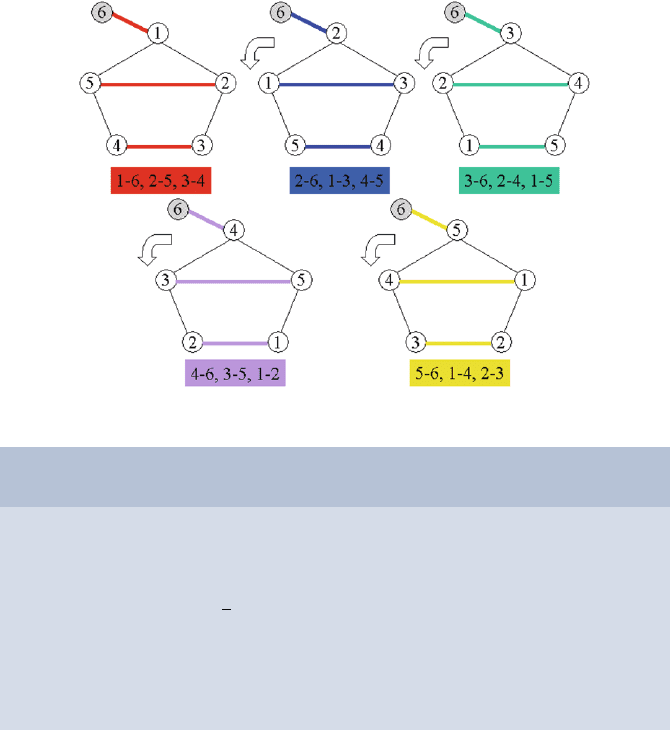
27 Scheduling of Tournaments or Sports Leagues 271
Fig. 27.4. Iterations of the procedure
The algorithm ColorEdges colors all edges of the complete graph with an
even number n of vertices with n − 1 colors.
1 procedure ColorEdges (n)
2 begin
3 for all colors i := 1 to n − 1 do
4 color edge [i, n] with color i
5 for k := 1 to
n
2
− 1
6 color all edges [(i + k)mod(n − 1), (i − k)mod(n − 1)]
7 with color i
8 endfor
9 endfor
10 end
In this algorithm a mod b denotes the remainder after dividing the integer
a by the integer b. For example,
• 14 mod 4 = 2, since 14 = 3 · 4+2,
• 9mod3=0, since 9=3·3+0and
•−1mod5= 4, since −1=(−1) · 5+4.
If we divide by the number n − 1 in Step 6, we get remainders from the set
0, 1,...,n− 2. Since our vertices are numbered by 1,...,n− 1 (and not by
0, 1,...,n−2), we identify the remainder 0 with n − 1.
In our example in Step 6 we get for i = 1 the edges
• [(1 + 1) mod 5, (1 − 1) mod 5] = [2, 5] for k =1,and
• [(1 + 2) mod 5, (1 − 2) mod 5] = [3, 4] for k =2.
The calculation of the values for i =2, 3, 4, 5 may be done by the reader.
272 Sigrid Knust
Schedules with Home–Away Assignments
Let us again consider a soccer league. In contrast to the table-tennis tourna-
ment, the matches are not performed at the same location, but in the stadi-
ums of the teams. If in the first half series the match between teams i and j
is scheduled in the stadium of team i, then in the second half series team j
is the home team. Thus, in a schedule for such a league, in addition to the
pairings (who plays whom) per round, for each pairing a home team has to
be determined.
For various reasons (e.g., fairness, attractiveness for the spectators) for
each team home and away matches should alternate as much as possible. If a
team has two consecutive home or away matches, this is also called a break
(the alternating sequence of H- and A-matches is broken). When breaks are
undesirable, a schedule without any breaks would be the best. But, if we have
a closer look at the schedules of different leagues in various sports disciplines
we see that in every season breaks occur. We may ask the question whether
breaks are unavoidable or whether better schedules (without any breaks) exist.
It is relatively easy to see that with respect to our constraints no schedule
without any breaks exists. If no team has a break, each team must have a
home–away sequence of the form HAHA. . . H or AHAH...A. On the other
hand, two teams with the same home–away sequence (e.g., HAHA. . . H) can
never play against each other (since always both teams play either home or
away). For this reason at most two teams can have a home–away sequence
without any break. Thus, the remaining n − 2 teams must have at least one
break, i.e., each schedule for a half series contains at least n − 2 breaks.
It can be shown that schedules with exactly n − 2 breaks exist which
can be generated with an extension of the algorithm described above. In this
extension additionally the home team has to be determined in Steps 4 and 6
of algorithm ColorEdges as follows:
• Any match [i, n] is a home match for team i if i is even; otherwise it is a
home match for team n.
• Any match [(i + k)mod(n − 1), (i − k)mod(n − 1)] is a home match for
team (i + k)mod(n −1) if k is odd; otherwise it is a home match for team
(i − k)mod(n − 1).
In our graph model, home and away matches can easily be integrated if the
edges are oriented. If the directed arc i → j means that the match between
teams i and j takes place at team j, then for our example with n = 6 teams,
using the extended algorithm we obtain the schedule from Fig. 27.5 with
n − 2
= 4 breaks (teams 1 and 6 have no break, teams 2, 3, 4, 5 each have
one break).
The
geometrical construction procedure based on the polygon can also be
extended by giving each edge an orientation. While the edges in the polygon
are always oriented in the same direction, the orientation of the edge to the
outer vertex n alternates in each iteration (see Fig. 27.6).
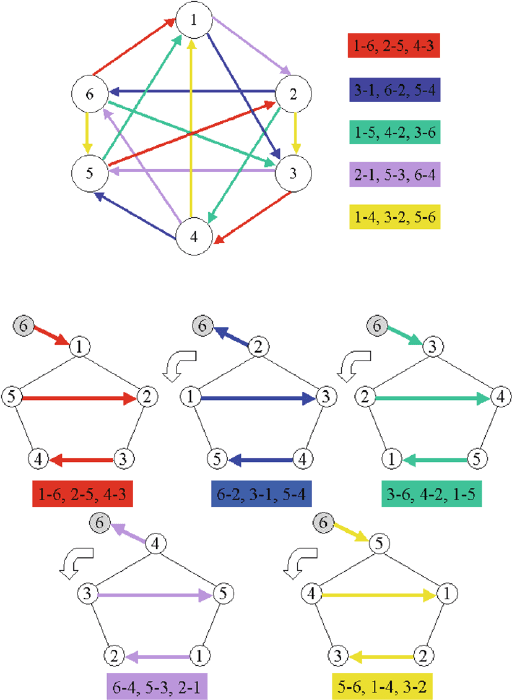
27 Scheduling of Tournaments or Sports Leagues 273
Fig. 27.5. Schedule with n − 2breaks
Fig. 27.6. Iterations of the extended procedure
Summarizing, we can state that for any even number n of teams a schedule
with n − 1 rounds and n − 2 breaks exists which can be constructed by the
described algorithm.
Finally, let us come back to the soccer league. Since there we have two
half series, in each half series at least n − 2 breaks occur. In the professional
German soccer league the matches of the second half series are scheduled in
the same sequence as in the first half series (with exchanged home rights). For
such a system it can be shown that at least 3n − 6 breaks occur. A schedule
having 3n−6 breaks (n−2 in both half series and n −2 at the border between
first and second half series) can easily be constructed with the above method.
Using a slight modification, it can additionally be ensured that no team has
two consecutive breaks.
274 Sigrid Knust
Usually, scheduling of a sports league in practice is more difficult since
additional constraints have to be respected. For example, if a league contains
teams which share the same stadium, two such teams cannot play at home
simultaneously. Thus, when one of these teams plays at home, the other must
play away. Furthermore, due to limited train or police capacities, not too
many matches should be played in a region at the same day. Additionally, it
may happen that in some rounds a stadium is unavailable since another event
(e.g., a concert or a fair) is already taking place. Then the corresponding team
has to play away in such a round. Finally, the media and spectators expect
a varied, eventful, and exciting season (e.g., top matches should be scheduled
at the end of a season) and attractive matches should be distributed evenly
over the season.
For now most sports leagues schedules are still constructed manually.
A scheduler generates a generic schedule for the corresponding league size
with the above algorithm where at first the numbers 1,...,n are used as
placeholders for the teams. Afterwards, in a second step each specific team
is assigned to a number (e.g., 1 = Werder Bremen, 2 = Hamburger SV, 3 =
Bayern M¨unchen, etc.). In this step as many additional constraints are met as
possible (e.g., that two teams sharing the same stadium never play at home
simultaneously).
Let us now consider how many different team assignments are possible for
a league with n = 18 teams. For the first number we can choose among 18
teams, and for the second number we have 17 possible teams (since the first
team is already chosen), then 16 possibilities for the third number, etc. Thus,
in total we get 18! = 18 · 17 · 16 ···· ·2 · 1 ≈ 6.4 · 10
15
possibilities. If we
assume that a computer can generate 10
9
solutions per second, we need 74
days in order to check all possibilities. This enormously huge number shows
that a human scheduler even with the help of a computer can only check a
very small number of possible schedules.
A further disadvantage of the described method is that only one specific
schedule is used as the foundation for the assignment. There are several other
schedules which cannot be generated with the above method. Thus, with
this procedure it cannot be guaranteed that good schedules (i.e., schedules
satisfying the given constraints as much as possible) are found. For this reason,
current research in the area of sports scheduling deals with the development
of new algorithms that try to calculate good schedules in a reasonable amount
of time.
Further Reading
1. Chapter 28 (Eulerian Circuits), Chap. 32 (Shortest Paths), Chap. 33 (Min-
imum Spanning Trees), Chap. 34 (Maximum Flows) and Chap. 40 (The
Travelling Salesman Problem).
27 Scheduling of Tournaments or Sports Leagues 275
Further models and algorithms based on graphs can be found in these
chapters.
2. J.M. Aldous and R.J. Wilson: Graphs and Applications. Springer, 2003.
An introduction to graphs and their applications.
3. Eric W. Weisstein: Kirkman’s Schoolgirl Problem. From MathWorld –
A Wolfram Web Resource:
http://mathworld.wolfram.com/KirkmansSchoolgirlProblem.html
An additional combinatorial problem where solutions can be represented
by graph colorings.
4. S. Knust: Construction Methods for Sports League Schedules
http://www.informatik.uos.de/knust/sportssched/webapp/index.
html
A website where different construction methods for sports league schedules
are shown (e.g., the construction methods discussed above).
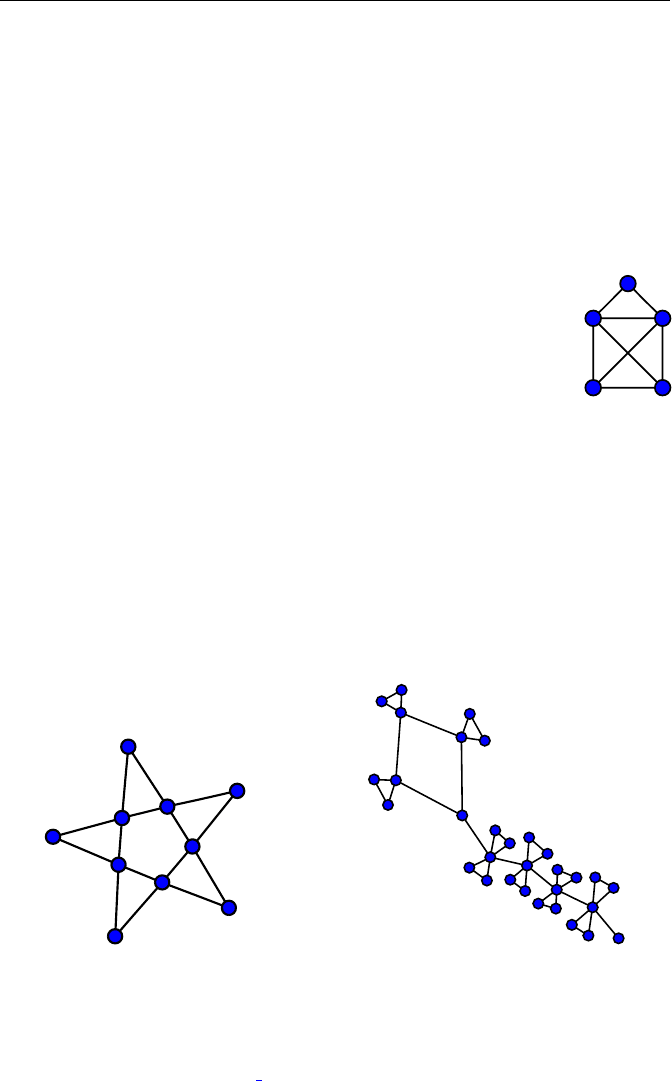
28
Eulerian Circuits
Michael Behrisch, Amin Coja-Oghlan, and Peter Liske
Humboldt-Universit¨at zu Berlin, Berlin, Germany
University of Warwick, Coventry, UK
Humboldt-Universit¨at zu Berlin, Berlin, Germany
Teasing your mates with riddles can be quite an amusing pastime
– provided that you know the answer already! The “House of
Santa Claus” provides a nice little teaser:
This figure consists of five nodes (the blue dots) and eight
edges (the lines that connect the nodes). Can you draw the House
of Santa Claus in one sweep, without lifting the pen and without
drawing any edge twice?
Of course, it won’t be long until all your friends know how to solve this
one (as there are actually 44 different ways of drawing the House of Santa
Claus). But fortunately there are plenty of other figures that can be drawn in
one sweep as well, provided that you know how. In some other cases you may
end up trying for quite a while, just to realize that drawing the figure in one
go seems all but impossible.
In this chapter we present an algorithm that will always produce a way to
draw a given figure in one go if this is possible. To devise such an algorithm,
let us first try to deal with figures that can be drawn in one sweep such that
Fig. 28.1. Try the star and the dragon!
B. V¨ocking et al. (eds.), Algorithms Unplugged,
DOI 10.1007/978-3-642-15328-0
28,
c
Springer-Verlag Berlin Heidelberg 2011
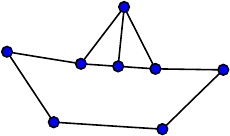
278 Michael Behrisch, Amin Coja-Oghlan, and Peter Liske
Fig. 28.2. The sailing boat provides a counterexample
the pen ends up at the same node where it started. The route that the pen
traverses is then called an Eulerian circuit. This is because the mathemati-
cian Leonhard Euler was the first to find out what figures can be sketched
in this way. (Actually Leonhard Euler was mostly interested in one partic-
ular figure, namely the roadmap of his home town of K¨onigsberg.) Follow-
ing Euler, we first deal with the question of whether an Eulerian circuit ex-
ists. Later on we sort out how to find an Eulerian circuit quickly if there is
one.
In what follows we are going to figure out why, for example, the star has
an Eulerian circuit, and why neither the House of Santa Claus nor the ship
admit one. Bizarrely, the House of Santa Claus can be drawn in one go if we
allow that the pen ends up at a different node than where it started, whereas
even this is impossible in the case of the ship. To find out why, we need to take
acloserlookatthenodes, i.e., the places where the pen can change direction.
(Recall that the nodes are just the blue dots in our figures.)
When Does an Eulerian Circuit Exist?
The degree of a node is the number of edges that pass through that node. For
instance, the degree of the mast top of the ship is three. If we draw a figure
in one sweep so that in the end the pen returns to the starting point, then
the pen leaves every vertex exactly as many times as it enters that vertex. In
effect, the degree of each node is even.
Observe that the ship has four nodes of odd degree (namely, all the nodes
that belong to the sail). This shows that it is impossible to draw the ship in
one go such that the starting point and the endpoint coincide. The same is
true of the House of Santa Claus, because it has two nodes of degree three.
However, there is a little twist (to be revealed later) that enables us to draw
the figure in one sweep, but with different starting point and endpoint. By
contrast, all nodes of the star have even degree. But does any figure with
this property feature an Eulerian circuit? And, if so, how do we actually find
one?
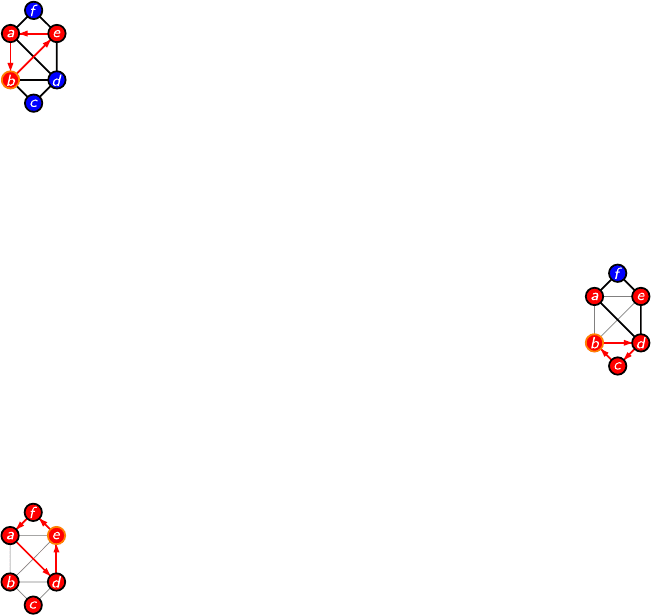
28 Eulerian Circuits 279
Finding Eulerian Circuits
Suppose that all nodes have even degrees. In the absence of a better idea,
we could just start somewhere and go ahead drawing.Thatis,westartatan
arbitrary node and follow an arbitrary edge to another node. Once we get
there, we pick another edge that we haven’t used before arbitrarily, and so
on.
Each time we enter or leave a node, we use up two of its edges (because
we are not allowed to use an edge more than once). Hence, if the node had an
even degree initially, the number of available edges at that node will remain
even. As a consequence, we won’t get stuck in a dead end. In other words, our
“just go ahead” strategy will eventually lead us back to the node where we
started.
In the left figure a circuit (i.e., a route through several edges
that leads back to the origin) consisting of three edges has
emerged. The circuit passes through the vertices b, e,anda.
Yet following the above strategy (“start somewhere and keep
on going until you get back to the origin”) does not necessar-
ily yield a circuit that covers all edges. Namely, we could have
taken a “shortcut” at some node, thereby skipping a part of the
figure. If this happens, we will need to extend the circuit that we have con-
structed so far. Before we do this, we remove the edges that we have visited
already (because we are not allowed to pass through the same edges again
anyway).
For instance, in the above figure upon returning to the origin
b, we can repeat the same procedure to construct another circuit.
In the above example the second circuit is a triangle through the
nodes b, d,andc (right figure).
Linking the two circuits that we have obtained so far, we
obtain a longer circuit (b,e,a,b,d,c,b). Alas, even this circuit
does not comprise all the edges. Hence, we are in for another
extension. Of course, since all the edges that pass through the start vertex
b are already used up, we need to pick another vertex to construct the next
circuit.
Observe that removing all edges that our current circuit
(b,e,a,b,d,c,b) passes through leaves us with a figure in which
all nodes have even degrees. Hence, we can easily find yet an-
other circuit as follows: Pick a node on the “old” circuit that
has an edge that we haven’t visited yet. Declare this node the
new starting vertex and proceed to find another circuit by fol-
lowing the “just draw ahead” strategy. In the above example we
get the quadrangle with the corners a, d, e,andf as shown in the left fig-
ure.
Thus, in addition to our “old” circuit we have got a new one that starts
and ends at some node of the old circuit. Now, the plan is to hook the new
